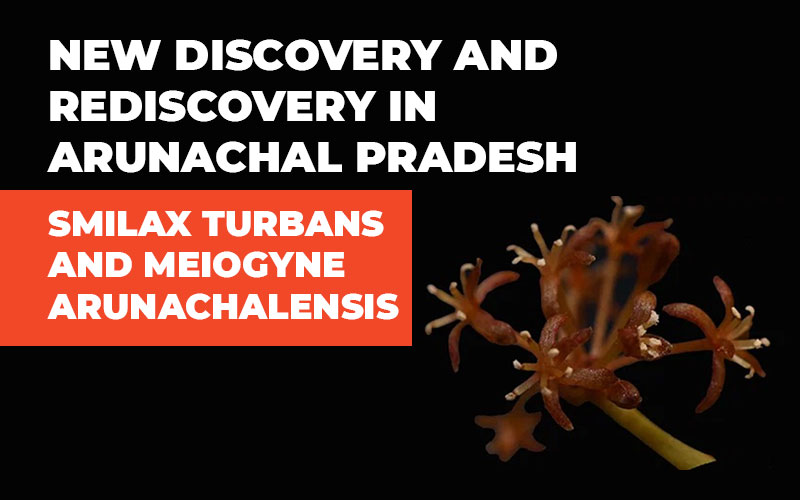
New Discovery and Rediscovery in Arunachal Pradesh: Smilax turbans and Meiogyne arunachalensis
In
recent years, Arunachal Pradesh, known for its rich biodiversity and enchanting
location, has experienced an enormous rise in popularity, partly due to its
vast and unexplored wilderness. The region has been actively identifying and
rediscovering numerous rare and endemic species over the past few years. Two of
the plant and tree species that have just been identified in recent months have
been highlighted in the following:
Meiogyne arunachalensis
Meiogyne
arunachalensis, named after the state, is a unique tree species that has only
recently been identified by scientists in the East Siang district, in the Adi
Hills of Arunachal Pradesh. This discovery is quite significant for the area.
This makes it yet another discovery, following the Namdapha National Park in
Changlang.
Through
their combined efforts, the Hem Chand Mahindra Foundation, the Wildlife
Institute of India, and the forest department of Arunachal Pradesh were able to
identify this new species of tree in the region. This discovery was made by researcher
Navendu Page while on a biodiversity excursion.
The
Meiogyne arunachalensis discovery was covered in a ground-breaking scientific
study that appeared in the Edinburgh Journal of Botany on May 19. This paper is
a significant development because it is the first account of the Meiogyne genus
in Northeast India and the Eastern Himalayan biodiversity hotspot. Researcher
Navendu Page emphasised that this discovery is not only the first of its kind
from the Eastern Himalayan and Northeast India regions but also the third
species of its sort to be discovered in India.
Meiogyne
arunachalensis may also be found in the surrounding districts of Lower Dibang
Valley and Lohit, as well as in some of the locations that lie alongside
Namdapha National Park in northern Myanmar. With a wide geographic distribution
throughout South and Southeast Asia, the Meiogyne genus has about 33 species
that are currently recognised. Because of its extraordinary tree height and
trunk girth, Meiogyne arunachalensis stands out as the largest species in the
Meiogyne genus to date. According to researchers, the Meiogyne maxiflora
species, which is found in Thailand, is somewhat similar to this new species,
although it differs from it in terms of vegetative and reproductive traits.
Smilax turbans
Botanists
have recently rediscovered the smilax turban in the pristine forests of the
Kurung Kumey district in Arunachal Pradesh. This long-lost plant species is
closely related to the well-known Ayurvedic medicinal herb Chopchini (Smilax
china). Since its last documented collection in 1928 by F. Kingdon-Ward, this
botanical specimen has not been acquired for nearly ninety years. This plant,
which is said to be endemic to Arunachal Pradesh, is an important Ayurvedic
herb and the wild variant of the Chopchini, a herbal plant.
Ritesh
Kumar Choudhary, a well-known researcher at the Agharkar Research Institute in
Pune, and Geetika Sukhramani, one of his doctorate students, played a role in
the plant's rediscovery. Following the rediscovery, they offered a thorough
description complete with photos taken under a microscope, distribution
information, phenological insights, field notes, and comparisons to closely
related species. Several steps were taken to make its accurate identification
and eventual conservation easier.
The
researchers will now start looking at how this native species fits into the
local ecology and how it interacts with other plants and animals because, in
addition to being a remarkable scientific accomplishment, the rediscovery of
smilax turbans is also important ecologically.
As
different smilax species are well known for their healing powers in
conventional medicine, these findings might have significance for medical
study. Chopchini, for instance, has anti-inflammatory properties and boosts
immune system performance. It also has positive effects on digestion and
reproductive health, making it an extremely significant botanical resource for
conventional Ayurvedic treatment.
The
finding of such species is significant because it deepens our understanding of
the region's uncommon flora and highlights the importance of active research
and conservation efforts in Arunachal Pradesh's biodiversity-rich region. The
rediscovery emphasises the importance of preserving such distinctive habitats
and attests to the enormous diversity of Arunachal Pradesh's flora. It also
serves as a reminder to continue research and exploration to find new species
and their potential benefits for human health and environmental wellbeing.
Disclaimer: The opinions expressed in this article are those of the author's. They do not purport to reflect the opinions or views of The Critical Script or its editor.

Newsletter!!!
Subscribe to our weekly Newsletter and stay tuned.

















Related Comments